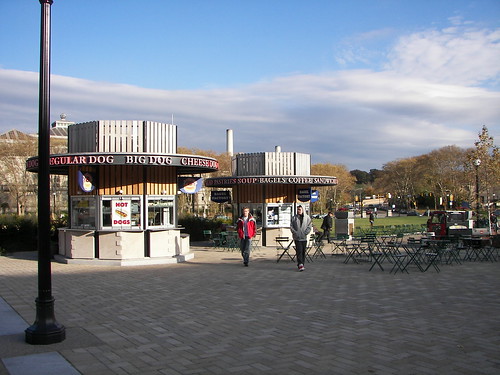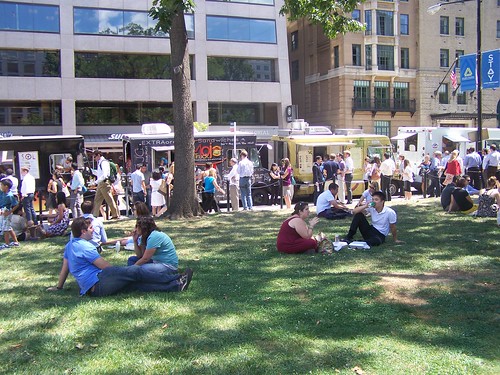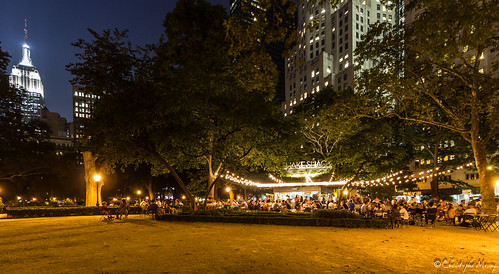Commerce as the engine of urbanism and parks
A couple weeks ago the Wall Street Journal had a good article on parks, "Cities' Message to Young Families: Play and Stay--New Features Include Parks, Playgrounds and Beer Gardens," and I was struck by the description of what we might call a blending of business and park, specifically food and beverage service, and that "beer gardens" are the most in-demand feature of new parks.
I guess it makes sense, given the historical connection to beer production, that Milwaukee County in Wisconsin has beer gardens in some of their parks, and a traveling beer garden park promotion program.
This reminds me of the comment by Professor Alex Wall, who wrote a book about Victor Gruen, one of the leaders in the development of shopping malls, which is:
"Commerce is the engine of urbanism."
The flip side is something that they teach in "Main Street Approach" commercial district revitalization training about "events" that there need to be four components: something to buy; something to do; music; and something to eat.
In short, it's about "activation" but also enabling people to refresh themselves. Sometimes that means eating. Other times that means going to the restroom. But when people can refresh themselves they can also stay longer.
Two entries back I mentioned the Mosaic District in Merrifield/Fairfax.
There is a big green, bracketed by a movie theater with an outside screen for open-air screenings, such as cartoons on Saturday mornings.
The "beer gardens" are on the perimeter, a bunch of restaurants with patios, although the movie theater also has outside food service, plus there is a coffee house building set up separately, supporting the green, and the coffeehouse brackets splash fountains for children and is set up like a beach, but without sand, with Adirondack chairs.
 This also reminds me of how food shacks, like Shake Shack in Madison Square Park, food service at Bryant Park, both in New York City, are essential activation elements in those parks.
This also reminds me of how food shacks, like Shake Shack in Madison Square Park, food service at Bryant Park, both in New York City, are essential activation elements in those parks.And in Schenley Plaza in Pittsburgh (pictured at right, but in late fall) as well.
Traditionally, we have been unable to do this in many equivalent spaces in DC because they are run by the National Park Service and subject to various laws and regulations limiting "non-park activity."
Unfortunately, the Park Service has had a difficult time creating a differentiated set of policies for urban parks, which are also complicated by the fact that many park spaces are subject to specific Congressional mandates.
For some of these NPS parks downwotn, the rise of food trucks has filled the breach, and they converge on various downtown parks and set up shop during lunch time.
 People lined up for Food Trucks, Farragut Square
People lined up for Food Trucks, Farragut SquareI noticed when we were in Salt Lake City that while Liberty Park doesn't have a food stand within, there looks to be a great cafe just across the street, the Park Cafe.
Being more liberal about commercial uses in spaces abutting parks is one way for cities to get around strictures they might have about for profit operations and food services within park spaces.
Salt Lake City's Pioneer Park is also home to the Saturday Downtown Farmers Market, which in my opinion has to be one of the top 15 farmers markets in the U.S., competitive maybe even better than Portland's and better than the Greenmarket in Union Square in NYC.

Shake Shack Madison Square by night by Christophe Meusy, on Flickr.
Labels: commodification of the public space, families and the city, public realm framework, public space management, urban design/placemaking, urban revitalization




4 Comments:
I would think there would be structural options for DC in terms of its parks. I have gone to the Sandy Hook in NJ a couple times this year. It's an NPS park that is part of the Gateway National Recreation Area. There's food vending inside it (food trucks as well as a restaurant space). Not sure how they set that up. There's also a call for monetizing more of the space, similar to the way that the Presidio in SF has set up a separate trust to run it. (But I believe the Presidio is still a NPS park and park of the GNR out there.) Also while Battery Park is part of the NYC Parks department, portions of it are NPS property (like Castle Clinton) and the ferries to Ellis Island. They all seem to work together to make that happen. Perhaps because it's "easy" for DC to just give up control to it's public squares and circles, its done without thinking or planning but such a loss of opportunity.
I used to be very critical of NPS. While I still am, what I figured out is that in DC, NPS is faced with hyper-scrutiny, because all of the DOI and Presidential staff are here, and all 535 members of Congress.
So they are very restricted in what they can do.
E.g., Golden Gate is 3000 miles away. Even the NY NPS parks will have the Congresspeople from the state advocating for their local interests in a way that is very difficult to do here.
In my writing on parks, I argue that DC needs to step up and providing comprehensive guidance on all park spaces in the city, because otherwise local and resident interests are under-represented by the NPS and other agencies (e.g., USDA on the National Arboretum, etc.).
Without laying out alternative frameworks, we can guarantee that alternatives will never be developed.
The other aspect is a lot of NPS properties here are pretty important. I'm not convinced that Circulators on the mall, or more food trucks, or some other trendy measures will really make much of a difference.
So I'd say that the key is finding those NPS properties that would benefit the most from DC guidance. Dupont/Meridian HIll would be great examples. The profusion of triangle parks outside the core is another.
Thank you for providing such a valuable information and thanks for sharing this matter to get Online medicine store from Dose Pharmacy medicine.
Post a Comment
<< Home